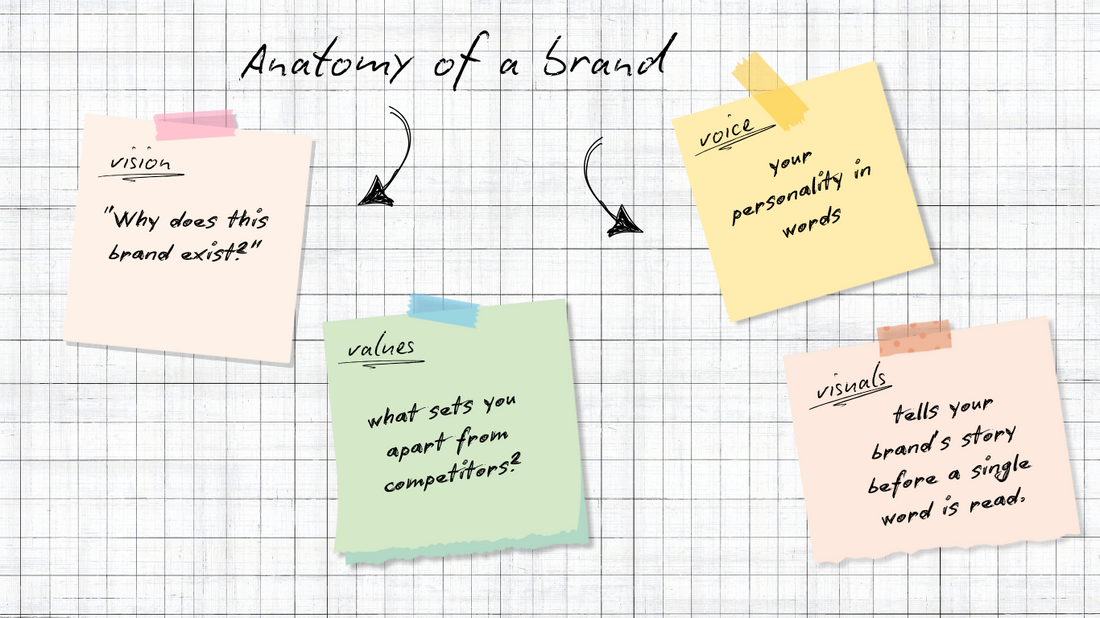Building a brand is so much more than choosing a pretty logo or a catchy tagline. A truly powerful brand is built on four essential pillars —Vision, Value, Voice, and Visuals. Together, these elements shape your business’s identity, define how you connect with customers, and ensure that your brand is unforgettable.
If you’ve ever struggled to articulate your brand’s essence or create a cohesive identity, this guide will walk you through each part of The Anatomy of a Brand and give you practical steps (and resources!) to craft your own.

Anatomy of a Brand 1. Vision: Your Brand’s North Star ✨
Your brand vision is the big-picture purpose of your business. It answers the fundamental question: “Why does this brand exist?” This isn’t just about what you sell—it’s about the deeper reason your brand matters.
How to Define Your Brand Vision:
Start by asking: What change do I want to make in the world?
Describe where you see your brand in 5 or 10 years —what’s different?
Identify your brand mission (the what and how) and your brand vision (the why).
📌 Resource: Simon Sinek’s TED Talk: "Start With Why" is a must-watch for defining your brand’s purpose.
💡 Example:
Nike’s vision isn’t just about selling shoes—it’s “To bring inspiration and innovation to every athlete in the world.” That’s the emotional connection that makes them an iconic brand.
2. Value: The Heart of Your Brand ❤️
How to Define Your Brand Value:
Identify three to five brand values that guide how you operate.
Pinpoint your Unique Selling Proposition (USP) —what makes you different?
Align your messaging and products with these values consistently.
📌 Resource: Use the Brand Archetype Framework (based on Carl Jung’s psychology) to understand your brand’s personality and values. You can explore it here for guidance.
💡 Example:
Patagonia stands for sustainability and environmental responsibility . Every decision they make—from supply chain choices to marketing—reflects that.
3. Voice: How Your Brand Speaks 🗣
How to Define Your Brand Voice:
Choose three to five words that describe your voice (e.g., friendly, honest, bold).
Define the tone you use in different situations (e.g., professional vs. casual).
Keep it consistent across all platforms.
📌 Resource: Check out Mailchimp’s Voice & Tone Guide here—it’s a great reference for how to shape a unique brand voice.
💡 Example:
Glossier speaks casually and intimately —like a friend recommending skincare. Their voice makes them feel approachable, despite being a global brand.
4. Visuals: The First Impression of Your Brand 🎨
How to Define Your Brand Visuals:
Choose brand colors that evoke the right emotions (e.g., blue = trust, yellow = optimism).
Select fonts and design elements that reflect your brand personality.
Keep your visuals consistent across social media, packaging, website, and emails .
📌 Resource: Use Canva’s Brand Kit to keep your visuals cohesive across platforms. Learn more here.
💡 Example:
Apple’s minimalistic aesthetic reflects simplicity and innovation —their branding is instantly recognizable worldwide.

Bringing It All Together
A strong brand isn’t built overnight. It takes intentionality, strategy, and consistency across all four pillars:
✅ Vision – The purpose behind your brand.
✅ Value – The promise you make to customers.
✅ Voice – The personality in your messaging.
✅ Visuals – The design that makes you memorable.
Want to craft your own Brand Anatomy ? Grab a notebook and work through each section above—defining your brand’s identity step by step.
💬 What’s your biggest challenge when it comes to branding? Drop a comment below, and let’s chat!




